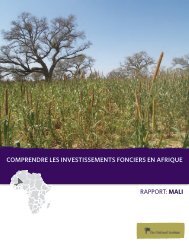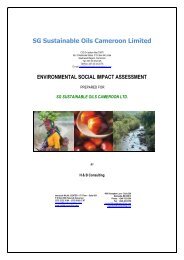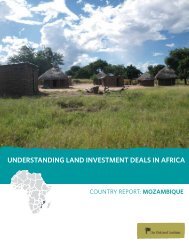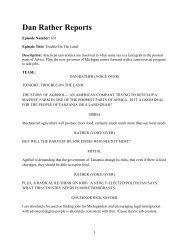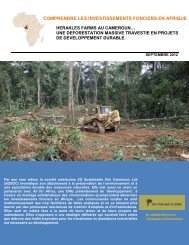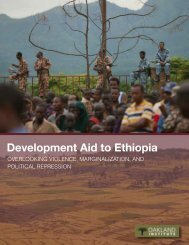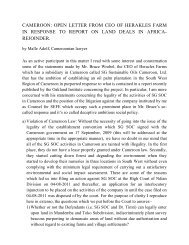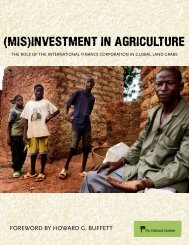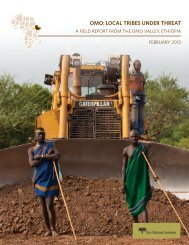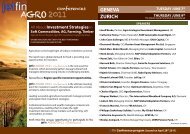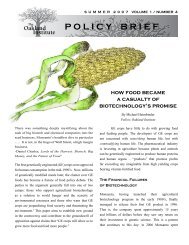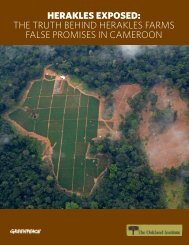understanding land investment deals in africa - Oakland Institute
understanding land investment deals in africa - Oakland Institute
understanding land investment deals in africa - Oakland Institute
- No tags were found...
Create successful ePaper yourself
Turn your PDF publications into a flip-book with our unique Google optimized e-Paper software.
exist<strong>in</strong>g fields has peaked and that oil revenues willdecl<strong>in</strong>e by approximately 50 percent over the next fiveyears. 34 S<strong>in</strong>ce oil revenue will not be available to susta<strong>in</strong>future generations, the government must develop othereconomic sectors to compensate for the eventual lossof oil <strong>in</strong>come. The RSS has focused on develop<strong>in</strong>g theagricultural sector as a way of diversify<strong>in</strong>g the economyaway from oil.Food SecurityWith more than a third of its population moderately orseverely food <strong>in</strong>secure, South Sudan is among the mostfood <strong>in</strong>secure countries <strong>in</strong> Sub-Saharan Africa. TheFAO and WFP estimate that a significant proportionof South Sudan’s population—as high as 33 percent<strong>in</strong> the lean season—depends on food aid to ensure am<strong>in</strong>imum level of nutritional <strong>in</strong>take. 35 Due to the lowlevels of domestic food production, South Sudan reliesheavily on food imports from neighbor<strong>in</strong>g countries,which has implications for both local and regional foodsecurity. The high transport costs associated with foodimports from Uganda, Kenya, and Sudan, coupled with<strong>in</strong>flation caused by the large <strong>in</strong>ternational presence,have caused food prices to skyrocket <strong>in</strong> South Sudan.The <strong>in</strong>crease <strong>in</strong> food exports to South Sudan is alsopartly responsible for ris<strong>in</strong>g food prices <strong>in</strong> Uganda andKenya.Despite the high levels of food <strong>in</strong>security <strong>in</strong> SouthSudan, agricultural production has showed somemodest improvement <strong>in</strong> recent years. Accord<strong>in</strong>g tothe FAO, both yields and total cultivated area havebeen gradually <strong>in</strong>creas<strong>in</strong>g over time. In 2004, SouthSudan produced only 490,000 metric tons of cereals,constitut<strong>in</strong>g approximately 46 percent of the country’stotal cereal requirements. 36 By 2008, however, cerealproduction topped one million metric tons for the firsttime <strong>in</strong> the post-CPA period. Production dropped to541,000 metric tons <strong>in</strong> 2009, mostly due to high levelsof <strong>in</strong>security and extensive flood<strong>in</strong>g across severalstates. It then rebounded to 695,000 metric tons <strong>in</strong>2010, fall<strong>in</strong>g short of domestic consumption needs by291,000 tons. 37While the statistics clearly demonstrate that domesticfood production <strong>in</strong> South Sudan is <strong>in</strong>sufficient to satisfydemand, the fact that the country was nearly food selfsufficient<strong>in</strong> 2008 speaks to the productive capacity ofSouth Sudanese smallholder farmers. What is needednow is consistency: If private <strong><strong>in</strong>vestment</strong> is properlychanneled to support smallholder farm<strong>in</strong>g through theprovision of agricultural <strong>in</strong>puts, technology transfers,and improved access to markets, it can help to levelout some of the year-to-year <strong>in</strong>consistencies <strong>in</strong> thecountry’s agricultural productivity. The RSS M<strong>in</strong>istryof Agriculture has announced its goal of boost<strong>in</strong>g foodproduction <strong>in</strong> South Sudan to two million metric tonsper year by 2013. 38 As discussed <strong>in</strong> Section 3 below,many governmental actors <strong>in</strong> South Sudan envisiona central role for <strong>in</strong>dustrial agriculture <strong>in</strong> achiev<strong>in</strong>gthis goal. By proceed<strong>in</strong>g with these large-scaleagricultural <strong><strong>in</strong>vestment</strong>s <strong>in</strong> the absence of a properregulatory framework, however, the government risksunderm<strong>in</strong><strong>in</strong>g smallholder productivity <strong>in</strong> the process.Box 4. Smallholder Farm<strong>in</strong>g <strong>in</strong> SouthSudanAccount<strong>in</strong>g for 80 percent of the country’s cereal production,smallholder farm<strong>in</strong>g dom<strong>in</strong>ates the agricultural sector <strong>in</strong> SouthSudan. Yet, smallholder farmers face a number of constra<strong>in</strong>ts,due to, among other th<strong>in</strong>gs, high transport costs, unavailabilityof agricultural <strong>in</strong>puts, and underdeveloped agriculturalextension services. The central and state-level m<strong>in</strong>istries ofagriculture have been operational s<strong>in</strong>ce 2005, but they arechronically underfunded and unable to deliver mean<strong>in</strong>gfulservices. Farmers must <strong>in</strong>stead rely on support from isolatedpockets of <strong>in</strong>put supply and agricultural extension throughdonor-funded emergency and humanitarian programs. 39Rather than <strong>in</strong>vest<strong>in</strong>g resources <strong>in</strong>to develop<strong>in</strong>g the k<strong>in</strong>dof agricultural extension services that could help to spursmallholder production, many government <strong>in</strong>stitutionshave turned towards large-scale, private sector-led <strong>in</strong>dustrialagricultural schemes as an easy way to boost food production.Accord<strong>in</strong>g to Mamer Kuer Ajak, a South Sudanese smallholderwho has a farm <strong>in</strong> Jonglei State where he grows groundnuts,maize, and sorghum: “The government is speak<strong>in</strong>g a corporatelanguage and is out of touch with communities.” 40In addition to the lack of government support, communitiesmust contend with vicious cycles of food <strong>in</strong>security andconflict. Dur<strong>in</strong>g the season when hunger is worst, roughlyfrom July to October, food prices rise and resource-basedconflicts beg<strong>in</strong> to erupt among neighbor<strong>in</strong>g groups. Theconflict often affects people’s ability to plant and harvest ontime, reduc<strong>in</strong>g their productivity <strong>in</strong> subsequent seasons. Thefact that smallholder producers have managed to cont<strong>in</strong>ue toproduce year-after-year under these circumstances speaks totheir resilience and adaptability.The Oak<strong>land</strong> <strong>Institute</strong> <strong>understand<strong>in</strong>g</strong> <strong>land</strong> <strong><strong>in</strong>vestment</strong> <strong>deals</strong> <strong>in</strong> <strong>africa</strong>: south sudan | 10



